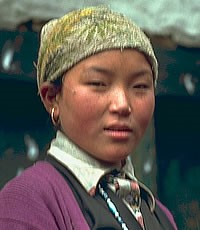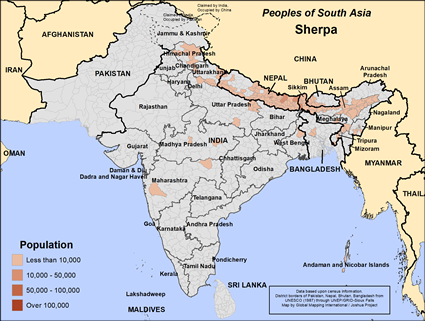The name Sherpa is derived from the Tibetan word sharpa, meaning "people from the East." A sub-group of the Bhotia, the Sherpas are a Tibetan-related ethnic group.
Many live in the Solukhumbu Valley, especially Pangboche village. This is the gateway to Mt. Everest, so they are in a good position to earn a living by helping wealthy foreigners with mountain treks and hospitality needs. In 1953, they gained worldwide attention (as well as a tourist industry) when a Sherpa climber named Tenzing Norgay accompanied Sir Edmund Hillary to the summit of Mount Everest.
Along with their homeland, several thousand live in Nepal's capital city of Kathmandu, in the Indian city of Darjeeling, and in Indian hill towns. Smaller numbers are in China and Bhutan. There is also a Sherpa diaspora in the United States.
The Sherpa language is a dialect of Tibetan and is part of the family of languages to which many other Nepali languages belong. All Sherpa speak Nepali, the official language of Nepal. While Sherpa is not a written language, many Sherpa are literate in Tibetan, Nepali, and occasionally, Hindu and English.
Other than tourism, the most important industry for the Sherpa is farming. Since its introduction to the region in the nineteenth century, the Irish potato has become the staple crop, with barley, wheat, and corn also being grown. Various vegetables are grown in home gardens, including radishes the size of turnips and cucumbers the size of watermelons. All farming is done using animals and hand implements, and plowing is accomplished with a single-bladed plow pulled by oxen. Many herdsmen have large amounts of extra butter and trade it for food and various commodities. Imported tea mixed with butter and salt is a popular drink, along with a local beer, chang.
Trade is another important source of income for the Sherpa. Men frequently go off on trading expeditions for several months at a time, leaving the women at home to supervise the household.
Sherpa marriages are exogamous (marry outside the immediate and brother clans). Weddings were traditionally arranged by the families of the young people involved, but today that tradition is beginning to change. Marriage is a long process involving many stages of betrothal and gift exchange. Divorce is very frequent, occurring in nearly one-third of all marriages. Fathers treat their children well, but due to their frequent trading trips, they are often gone from home for long periods. As a result, child rearing is carried out mainly by the mother and older sisters.
The major Sherpa celebrations include Dumje, a spring first-fruits festival, and Cham, a monastic masked dancing ritual that is held in the fall or winter. Smaller celebrations include village exorcisms and cleansing rites that often parallel life cycle events such as birth, death and initiation into adulthood.
Sherpas are known to throw parties to gain favor from their neighbors and communities. Hosting a party to manipulate guests is called yangdzi. Guests are seated by status, and everyone tries to sit in a place of less status so the host will take them to a better place. During the first hour they drink bear. Then they eat dinner followed by hours of singing and dancing.
The great majority of the Sherpa follow the Tibetan Buddhist religion, which is an offshoot of the Mahayana branch of Buddhism. Followers of Buddhism embrace the doctrine of reincarnation, or the belief that after death, a soul is reborn into another body. The Sherpa believe that souls are reincarnated innumerable times until they are able to transcend this world and enter a state of bliss called nirvana. However, in order to enter nirvana, a person is required to conquer his own worldly desires and habits-a goal that is attained by observing Buddhist commands. Tibetan Buddhism shares basic beliefs with mainstream Buddhism; however, it also contains many non-Buddhist elements, such as the belief in many gods, demons and spirits who influence human lives.
Like the majority of people in the northern mountains of India, the Sherpa live difficult lives. Their physical needs are numerous. There is a small Sherpa church in India, but they have a long way to go to make sure all have heard the gospel.
Ask the Lord of the harvest to send forth laborers to live and work among the Sherpa.
Pray for the Holy Spirit to give Sherpas in India a hunger and thirst for righteousness that will lead them to Christ.
Ask God to strengthen, encourage, and protect the small number of Sherpa Christians.
Ask the Holy Spirit to complete the work begun in the hearts of the Sherpa believers through adequate discipleship.
Pray for Sherpa Christ followers in India to reach others in Nepal and China.
Scripture Prayers for the Sherpa in India.
https://en.wikipedia.org/wiki/Sherpa_people
| Profile Source: Joshua Project |













